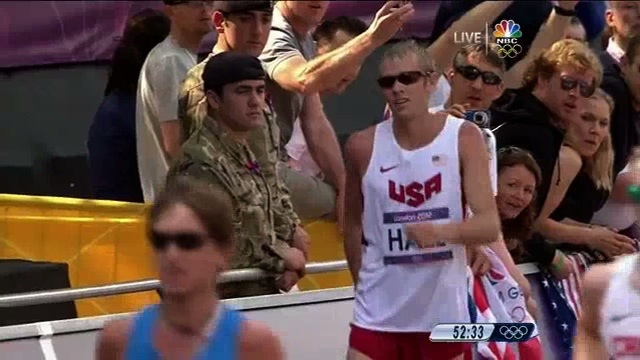Plantar Fasciits: Olympic Marathoner Ryan Hall pulls out of New York Marathon.
Unfortunate and sad news again in the running community as Ryan Hall has announced he is dropping out of the New York City Marathon due to “several nagging injuries.” I had blogged about his injuries before as his chance at the gold medal in London fell short at mile ten as he stopped due to hamstring tightness interfering with his gait. It just frustrates me to hear that he is still being plagued by plantar fasciitis. He admitted the problem began last november (http://news.runnersworld.com/2012/03/07/ryan-hall-has-plantar-fasciitis/) upon which he took 3 weeks off and had an MRI done to rule out any underlying stress fractures. At this time his treatment was being rendered by chiropractor John Ball of Phoenix an had consisted of shockwave therapy, as well as the traditional night splint, stretching, massage, golf ball and strengthening. He also admitted that he needed to spend more time doing strengthening exercises with his feet.
Plantar fasciitis is an epidemic in our society that should without a doubt not exist to the extent that it does. It is an overuse phenomenon that is secondary to weak musculature that can be prevented. Dr. Irene Davis, PhD, PT, FAPTA, director of the Spaulding National Running Center of Harvard Medical School, admits that she came to the realization that flip flops were not the culprit of plantar fasciitis because of lack of support. It was happening to feet that were weak from being in traditional supportive shoe great for most of the year and when the weather improved the rapid change to a non supportive shoe was too much stress to the weak foot. It is not the flip flop itself. I see this numerous times daily in my practice. Many of my patients careers force them to wear stiff soled shoes which puts them at great risk for plantar fasciitis by inhibiting motion and thus inducing weakness to the foot muscles. This ultimately leads to an overuse injury sometimes as a result of the normal activities that we perform daily.
Another interesting fact is that roughly forty years ago the medical field had considered this same condition to be caused by “heel spurs” on the calcaneous or heel bone. Years later it was established that the spur was not the true cause of pain and that many people who had existing heel spurs did not suffer from heel pain. It was then renamed as plantar fasciitis and described as a inflammation of the plantar fascia at its insertion site on the heel bone. Ironically, when microscopic studies have been performed on cases of chronic plantar fasciitis, there were no inflammatory cells noted within the tissue. Several studies have repeated these findings. 1,2.
Anatomically speaking, immediately next to the plantar fascia is a muscle known as the abductor hallucis. It just so happens that this muscle is the main supporter of the arch. 3,4,5 When muscles and tendons become inflamed, they tend to become painful when upon arising in the morning after not being used at night. This is a classic finding in any tendinitis. Plantar fasciitis is routinely known for being painful in the AM when first getting out of bed. Is an over used and weak abductor hallucis muscle the culprit for heel pain? Should this chronic condition be renamed abductor hallucis tendinitis?
So lets not blame Halls’ heel pain on weak foot musculature, after all he should have strong feet given all the miles he puts on them. But, could these miles he’s logging traditional trainers be putting him at risk?
1. Lemont H, Ammirati KM, Usen N. Plantar fasciitis: a degenerative process (fasciosis) without inflammation. J Am Podiatr Med Assoc. 2003 May-Jun;93(3):234-7.
2. Wearing SC, Smeathers JE, Urry SR, Hennig EM, Hills AP. The pathomechanics of plantar fasciitis. Sports Med. 2006;36(7):585-611
3. Fiolkowski P, Brunt D, Bishop M, Woo R, Horodyski M. Intrinsic pedal musculature support of the medial longitudinal arch: an electromyography study. J Foot Ankle Surg. 2003 Nov-Dec;42(6):327-33.
4. Jung DY, Kim MH, Koh EK, Kwon OY, Cynn HS, Lee WH. A comparison in the muscle activity of the abductor hallucis and the medial longitudinal arch angle during toe curl and short foot exercises. Phys Ther Sport. 2011 Feb;12(1):30-5. Epub 2010 Sep 15.
5. Wong YS. Influence of the abductor hallucis muscle on the medial arch of the foot: a kinematic and anatomical cadaver study. Foot Ankle Int. 2007 May;28(5):617-20.






Something is being missed with Hall’s rehab. Foot trouble can be a symptom of other issues higher up the kinetic chain such as pelvic/SI joint lumbar spine or knee trouble. Whenever there is a lower eternity overuse/chronic injury on one side of the body a thorough gait analysis as well as joint by joint assessment and muscle function assessment needs to be done. Stretching/strengthening the foot will not solve his trouble if the issues are higher up the kinetic chain
Something is being missed with Hall’s rehab. Foot trouble can be a symptom of other issues higher up the kinetic chain such as pelvic/SI joint lumbar spine or knee trouble. Whenever there is a lower eternity overuse/chronic injury on one side of the body a thorough gait analysis as well as joint by joint assessment and muscle function assessment needs to be done. Stretching/strengthening the foot will not solve his trouble if the issues are higher up the kinetic chain
Plantar Fasciitis is a huge topic. And I know it is impossible to cover every single thing in one blog post. However, to find the root cause, looking beyond the foot is critical.
One consistency with plantar fasciitis is this: the patient/client/athlete can not lock up the rear-foot for an efficient propulsion. And there are a tremendous amount of muscles above the level of the foot and lower leg that are responsible for locking up the rear-foot in gait. In fact, there are muscles that have to concentrically contract (shorten) to pull the swing leg through, which in turn drives motion from the top down on the opposite side. So, in order to restore function so that the client/patient/athlete is performing better than they were prior to the injury, the goal is bilateral symmetry.
I agree that abductor hallucis is an important intrinsic muscle. But it can not work alone. In other words, the client/patient/athlete could have an abductor hallucis that is receiving the appropriate amount of neurological input to contract at the right time, in the right plane and at the right joint, but it can only do so much since it is *only* isolated to the foot. Meanwhile, the tibialis anterior, peroneus (fibularis) longus, tibialis posterior and soleus are neurologically inhibited and they are not capable of generating enough internal force (a pull!) to lock up the rear foot for an explosive propulsion.
One of the biggest misconceptions in rehab (and prehab!) is this: it is impossible to strengthen a muscle that is neurologically inhibited. And trying to strengthen any muscle prior to restoring the neurological input *only* reinforces the pre-existing compensations.
Plantar Fasciitis is a huge topic. And I know it is impossible to cover every single thing in one blog post. However, to find the root cause, looking beyond the foot is critical.
One consistency with plantar fasciitis is this: the patient/client/athlete can not lock up the rear-foot for an efficient propulsion. And there are a tremendous amount of muscles above the level of the foot and lower leg that are responsible for locking up the rear-foot in gait. In fact, there are muscles that have to concentrically contract (shorten) to pull the swing leg through, which in turn drives motion from the top down on the opposite side. So, in order to restore function so that the client/patient/athlete is performing better than they were prior to the injury, the goal is bilateral symmetry.
I agree that abductor hallucis is an important intrinsic muscle. But it can not work alone. In other words, the client/patient/athlete could have an abductor hallucis that is receiving the appropriate amount of neurological input to contract at the right time, in the right plane and at the right joint, but it can only do so much since it is *only* isolated to the foot. Meanwhile, the tibialis anterior, peroneus (fibularis) longus, tibialis posterior and soleus are neurologically inhibited and they are not capable of generating enough internal force (a pull!) to lock up the rear foot for an explosive propulsion.
One of the biggest misconceptions in rehab (and prehab!) is this: it is impossible to strengthen a muscle that is neurologically inhibited. And trying to strengthen any muscle prior to restoring the neurological input *only* reinforces the pre-existing compensations.
Plantar Fasciitis is a huge topic. And I know it is impossible to cover every single thing in one blog post. However, to find the root cause, looking beyond the foot is critical.
One consistency with plantar fasciitis is this: the patient/client/athlete can not lock up the rear-foot for an efficient propulsion. And there are a tremendous amount of muscles above the level of the foot and lower leg that are responsible for locking up the rear-foot in gait. In fact, there are muscles that have to concentrically contract (shorten) to pull the swing leg through, which in turn drives motion from the top down on the opposite side. So, in order to restore function so that the client/patient/athlete is performing better than they were prior to the injury, the goal is bilateral symmetry.
I agree that abductor hallucis is an important intrinsic muscle. But it can not work alone. In other words, the client/patient/athlete could have an abductor hallucis that is receiving the appropriate amount of neurological input to contract at the right time, in the right plane and at the right joint, but it can only do so much since it is *only* isolated to the foot. Meanwhile, the tibialis anterior, peroneus (fibularis) longus, tibialis posterior and soleus are neurologically inhibited and they are not capable of generating enough internal force (a pull!) to lock up the rear foot for an explosive propulsion.
One of the biggest misconceptions in rehab (and prehab!) is this: it is impossible to strengthen a muscle that is neurologically inhibited. And trying to strengthen any muscle prior to restoring the neurological input *only* reinforces the pre-existing compensations.
He’s being treated by a chiropractic physician not by a podiatrist. The dude starts all of his thinking high up – Ryan that is…. And the chiropractor certainly starts thinking no lower than the SI joint, back and hips. He may need to see a foot specialist.
He’s being treated by a chiropractic physician not by a podiatrist. The dude starts all of his thinking high up – Ryan that is…. And the chiropractor certainly starts thinking no lower than the SI joint, back and hips. He may need to see a foot specialist.